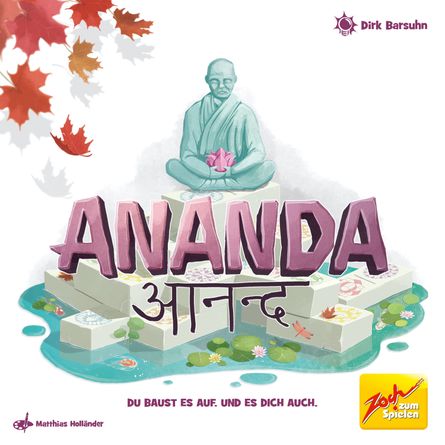SMOOSH JUICE
Game Review: Ananda, or The Unbearable Lightness of Gameplay | BoardGameGeek News

The cover of Ananda, a 2-4 player game from Dirk Barsuhn and Zoch Verlag that debuted at SPIEL Essen 24, promises a certain vibe: meditative, calm…perhaps enlightened?
The game’s name comes from Ānanda, one of the Buddha’s ten principal disciples, as well as his cousin and his primary attendant. “During the first years of his life as a monk Ānanda was fully occupied with the purification of his own mind; he blended easily into the Sangha [the monastic order] and slowly developed more and more resilience and mental strength”, write Hellmuth Hecker and Nyanaponika Thera in their book Great Disciples of the Buddha: Their Loves, Their Works, Their Legacy, an excerpt of which was published in Tricycle in 1998. What’s more:
In Ananda the game, you are unlikely to behave in such a selfless manner. You are represented in the game by a monk, yes, but you are a competitive monk who wants to meditate more than others. Perhaps you’re trying to prove yourself the ideal meditative model for others, or you’re offering a few chumps the chance to lose gracefully and live the words of the Buddha: “Holding on to anger is like grasping a hot coal with the intent of throwing it at someone else; you are the one who gets burned.”
Apart from the historical personage, the word “ānanda” — written as आनन्द in Sanskrit, as on the box cover — means bliss, joy, or happiness, and to receive joy in this game, you must meditate, and to meditate, you need an area in which to meditate, and beyond that you must add something to that area as a physical representation of your will.
In game terms, on a turn you move your monk to an unoccupied colored area, add one or more tiles to the board with each tile having a square of that color that abuts your area, calculate the size of that area, then (optionally) meditate…which is instantiated in the form of you playing cards of a matching color from your hand that add up to at most the size of the area your monk occupies.
In the image above, for example, if I move my pink monk to the red area, then place a tile from my hand to make a red area of size 4, I can then “meditate” the red 4 out of my hand — which will score me 4 points at game’s end.
However…
After you meditate, you subtract your meditation value from the size of the area you created, then draw that many tiles from the face-down supply — so in the example above, I would draw zero tiles. Do this enough times, and you run low on tiles, which means you can’t make large areas, which means you’ll barely be able to meditate, and the spiritual tank of your karma will run dry.
Meditation is a choice, though. I could decide not to play the red 4 from my hand, which means I’d then draw four tiles since the area size (4) minus my meditation value (0) is 4. Alternatively, I could play both tiles with red to make an area of size 5, then meditate the red 4 and draw one tile.
Managing your hand of tiles is important for another reason. To end your turn, if you have fewer cards in hand than the number of tiles on your rack, you draw cards to make up the difference — so if I play no cards, then I’ll draw four tiles, then subsequently draw three cards (since I have eight tiles on my rack, but only five cards in hand).
But if I don’t meditate, I don’t score, so…
As you might guess, Ananda is all about balance. Throughout the game, you’ll have an ebb and flow of tiles and cards. You suddenly have the chance to score 6 blue, and you’re like, well, when will I have this opportunity again? Later, you’ll play a single tile to bump an area to size 4-5, then scorn meditation to load up on tiles followed by cards. Around and around it goes…
Coincidentally, a second incarnation of this game concept was released at SPIEL Essen 24: Einfach Genial 3D, from Reiner Knizia and KOSMOS. In both games, players place domino-style tiles that feature symbols in six colors into a shared space (with one tile able to straddle two others) so that players can score points in those colors. If you imagine these games as cousins, I suppose that would make Einfach Genial 3D the Buddha. Hmm…
Both games allow players to lean into their mean side should they wish…to win. In Ananda, a player can’t move their monk into an occupied area (since it would disturb their fellow pilgrim), which means that the area you create can’t be claimed until after your next turn, which means you’re potentially setting up the player to your left, which means you’re often trying to figure out how to build up an area in a way that you can then cover it up on your next turn. The feel is akin to ye olde arcade game Crush Roller or the far newer Splatoon, but with you changing colors constantly to cover your past work. (You can see examples of this in the two images above.)
That said, if I should be in a green area, another monk could plant themselves in a separate green area, then place tiles that merge the two greens into one, effectively merging our two minds into one — but only they can meditate points from the result.
Einfach Genial 3D, which I reviewed in December 2024, plays somewhat similarly to Ananda in that you’re simultaneously trying to build for yourself, set up your next turn, and bury possibilities for others. Everyone’s color holdings are public, which means I know that you desperately need yellow to boost your final score, which means I’ll prevent yellow clusters as much as possible — but that’s not always possible depending on the development of the game board, with unplayable pits and valleys coming into shape as the turns past.
In Ananda, you meditate publicly, but then you stack those cards to the side, so to know everyone’s score — that is, the sum of their meditation — you’d have to remember who played what, and this element highlights one difference between the two games.
Ananda seems aimed more at casual gamers because unless you remember what everyone has scored in each color, you might not be sure which colors to cover as you play.
More importantly, in Einfach Genial 3D you have to deal with the luck of the draw, but you also have opportunities to flush tiles from your hand and replace them, thereby allowing you to boost your luck. In Ananda, you have to deal with the luck of the draw for both tiles and cards, and you can’t flush cards from your hand — which means you can’t score if those colors don’t show up in your hand of tiles, and the only way to “flush” tiles from your hand is to play them, which hastens the end of the game, unlike in Einfach Genial 3D when flushed tiles return to the supply.
Sometimes everything works out perfectly, as in the situation above with both tiles and cards bursting with blue, orange, and purple. At other times, however, you might have a hand of eight cards filled with mostly red and orange, with little to play to score them. Desperate for better options, you play five tiles with green, score nothing in order to draw five more tiles, and still end up with no red or orange.
In short, luck seems to play a higher role in the outcome of Ananda compared to Einfach Genial 3D.
This situation is exacerbated when playing with more people. The number of tiles used in Einfach Genial 3D scales based on the player count — 78 tiles with four players, 72 with three, and 60 with two — whereas in Ananda you use all 63 tiles no matter the player count, which means you start with 12/18/24 tiles removed from the pool for games that have 2/3/4 players. The game ends immediately once one player has placed their final tile after all the tiles have been claimed from the pool, so with four players compared to two, the tile pool has 39 tiles instead of 51.
As you can imagine, you will have many fewer turns in a four-player game than in a game with two players, which means you’ll have less time to dig yourself out of a color trap. If you “flush” five tiles in a four-player game, for example, you’ve scored nothing while using one-eighth of the tile pool. Hope you drew something good for next turn!
I’ve played Ananda five times on a review copy from Zoch Verlag, twice each with two and four players and once with three. I love the two-player game, like the three-player game, and find the four-player game acceptable — but that’s partly because both of those games had new players, and I thought they were missing out on the intriguing and challenging elements present in the two-player game.
In one four-player game, one player played tiles, scored nothing, and drew new tiles multiple times, rushing us all to the finish line. I was ready to apologize for the experience, then in their final turn, they played a bunch of purple and scored 10 points from all their purple cards in hand, coming in second by 1 point. Boom!
Okay, maybe the four-player game isn’t ideal, but it still provides moments. Honestly, this might just be a matter of experience, learning when to play minimally and when to punch the gas — something you have more time to explore in a two-player game since you’re playing twice as many tiles.
For more examples of gameplay and additional rule details, watch this video:

/pic8415416.jpg)
/pic8838345.jpg)
/pic8838655.jpg)
/pic8838657.jpg)
/pic8101973.jpg)
/pic8580397.jpg)
/pic8839263.jpg)
/pic8839927.jpg)